初中英语七年级下册教案
- 格式:doc
- 大小:156.00 KB
- 文档页数:24

七年级英语下册教学计划七年级英语下册教学计划(通用10篇)时间流逝得如此之快,我们又将接触新的知识,学习新的技能,积累新的经验,立即行动起来写一份计划吧。
相信许多人会觉得计划很难写?下面是店铺为大家收集的七年级英语下册教学计划,仅供参考,大家一起来看看吧。
七年级英语下册教学计划篇1一个寒假转眼间就过去了,新的学期又将开始,为了下学期更好地搞好七级英语教学工作,特做以下教学计划:一、指导思想依据学生上学期掌握知识情况和学生的生理和心理以及发展需求,本学期我们的英语课程的教学目的是如何培养学生的口语表达能力、听力水平和语言表达能力。
教师要激发学生学习英语的兴趣,培养他们学习英语的积极态度,使他们建立学习英语的自信心;培养学生的语感和良好的语音、语调基础,使他们形成初步运用英语进行日常交流的能力,为进一步学习打下基础。
同时用新课标理念,结合新课标精神,进行课堂改革,实行教与学的互动。
采用任务型语言教学模式,努力用一套行之有效的课堂教学模式,提高教学效率。
二、基本情况经过一学期的学习体会,我所教的两个班,大部分学生学习目的明确,学习态度端正,掌握了英语学习的一些基本方法,能够积极主动认真地学习,学习成绩较好。
但还有少部分学生没有明确的学习目的,缺少学习的热情和主动性,自觉性和自控力都较差,相应的学习习惯也差。
主要原因是没有激发学生学习英语的兴趣,学生觉得英语学习是一种负担,而不是一种乐趣。
一部分学生没有掌握记忆单词的方法,连基本的单词听写也不过关,导致看不懂,听不懂,学不懂。
学生的听力也还有待提高,在这方面失分也较多。
主要是听的时间太少,接触英语的时间不多。
针对种种问题,在本学期的英语教学中,教师一方面应加强基础知识的讲解和基本技能的训练,让学生掌握词汇、语法、句型等基础知识和听、说、读、写等基本技能,为进一步学习英语打下坚实的基础;另一方面,又要采取多种措施,注意培养学生对英语的兴趣;让学生掌握记忆单词、听力、写作等英语学习技艺,培养良好的学习习惯和自主探索,合作探究能力。
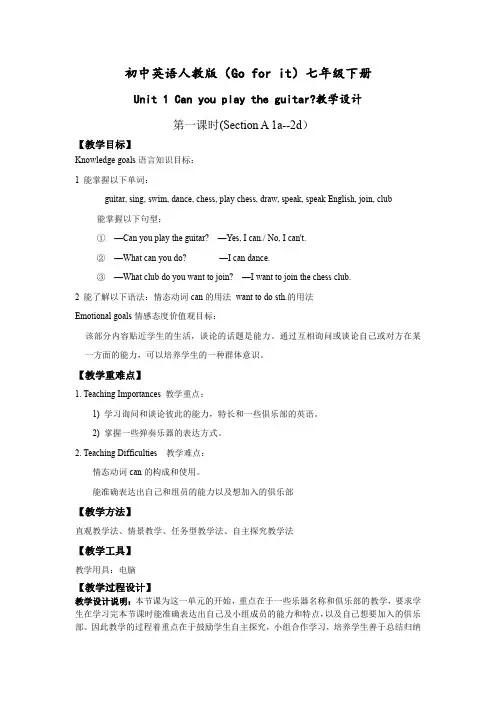
初中英语人教版(Go for it)七年级下册Unit1Can you play the guitar?教学设计第一课时(Section A1a--2d)【教学目标】Knowledge goals语言知识目标:1能掌握以下单词:guitar,sing,swim,dance,chess,play chess,draw,speak,speak English,join,club能掌握以下句型:①—Can you play the guitar?—Yes,I can./No,I can't.②—What can you do?—I can dance.③—What club do you want to join?—I want to join the chess club.2能了解以下语法:情态动词can的用法want to do sth.的用法Emotional goals情感态度价值观目标:该部分内容贴近学生的生活,谈论的话题是能力。
通过互相询问或谈论自己或对方在某一方面的能力,可以培养学生的一种群体意识。
【教学重难点】1.Teaching Importances教学重点:1)学习询问和谈论彼此的能力,特长和一些俱乐部的英语。
2)掌握一些弹奏乐器的表达方式。
2.Teaching Difficulties教学难点:情态动词can的构成和使用。
能准确表达出自己和组员的能力以及想加入的俱乐部【教学方法】直观教学法、情景教学、任务型教学法、自主探究教学法【教学工具】教学用具:电脑【教学过程设计】教学设计说明:本节课为这一单元的开始,重点在于一些乐器名称和俱乐部的教学,要求学生在学习完本节课时能准确表达出自己及小组成员的能力和特点,以及自己想要加入的俱乐部。
因此教学的过程着重点在于鼓励学生自主探究,小组合作学习,培养学生善于总结归纳知识,善于反思的品质。
设计主线为:新学期学校俱乐部招新,欣赏学生才艺展示。

七年级英语外研版下册教案通用5篇七年级英语外研版下册教案通用5篇英语教师研制一份教案,是为了加强课堂教学的目的性和计划性。
下面是小编为你准备的七年级英语外研版下册教案,快来借鉴一下并自己写一篇与我们分享吧!七年级英语外研版下册教案篇1一、指导思想在本学期的英语教学中,坚持《英语课程标准》中以下教学理念,面向全体学生,关注每个学生的情感,激发他们学习英语的兴趣,帮助他们建立学习的成就感和自信心,让学生在老师的指导下通过感知、体验、实践、参与和合作等方式,实现任务的目标,感受成功;注重过程评价,促进学生发展,建立能激励学生学习兴趣和自主学习能力发展的评价体系。
总之,让学生在使用英语中学习英语,让学生成为使用者而不仅仅是学习者。
让英语成为学生学习生活中最实用的工具而非累赘,让他们在使用和学习英语的过程中,体味到轻松和成功的快乐,而不是无尽的担忧和恐惧。
二、教材分析这套教材采用任务型语言教学模式,融汇话题、交际功能和语言结构,形成了一套循序渐进的生活化的学习程序。
与原教材相比还增加了文化背景和学习策略等部分,并增加了任务型学习成份和语篇的输入。
本书每个模块都列出明确的语言目标、主要的功能项目与语法结构、需要掌握的基本词汇,并分为三个单元。
Unit1部分是基本对话内容,Unit2部分是短文,主要是阅读训练。
Unit3是扩展和综合的语言运用。
三、学生基本情况分析我所任教的是七年级1、2班英语,只有少部分学生的英语基础较好,取得了一定的成绩,大多数学生不能明确学习英语的目的,没有真正认识到学习英语的目的在于交流;没有养成良好的.学习习惯,不能做好课前预习课后复习,不善于发现和总结语言规律,不注意知识的巩固和积累。
四、具体措施1、每天背诵课文中的重点对话。
目的:要求学生背诵并默写英语句子,培养学生良好的英语语感。
2、每天听写本节课中需要用到的重点生词,常用句子或习语。
利用“互测及教师抽查”及时检查,保证效果并坚持下去。
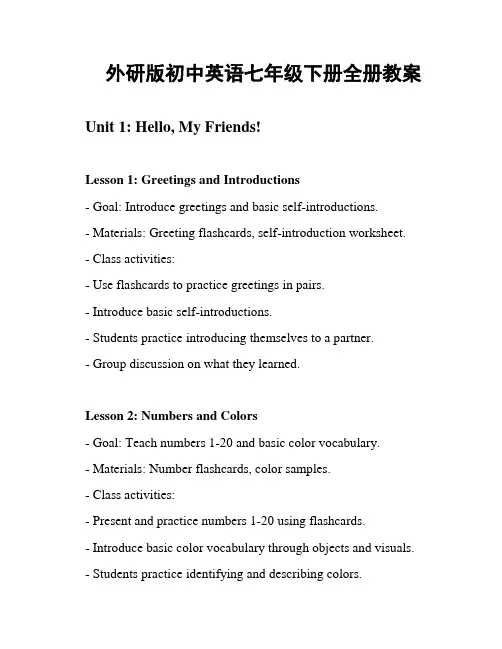
外研版初中英语七年级下册全册教案Unit 1: Hello, My Friends!Lesson 1: Greetings and Introductions- Goal: Introduce greetings and basic self-introductions.- Materials: Greeting flashcards, self-introduction worksheet. - Class activities:- Use flashcards to practice greetings in pairs.- Introduce basic self-introductions.- Students practice introducing themselves to a partner.- Group discussion on what they learned.Lesson 2: Numbers and Colors- Goal: Teach numbers 1-20 and basic color vocabulary.- Materials: Number flashcards, color samples.- Class activities:- Present and practice numbers 1-20 using flashcards.- Introduce basic color vocabulary through objects and visuals. - Students practice identifying and describing colors.- Reinforce learning with a color-matching game.Unit 2: My Family and My HomeLesson 1: Family Members- Goal: Learn how to talk about family members in English.- Materials: Family tree diagram, family member flashcards.- Class activities:- Introduce family member vocabulary using flashcards.- Present a family tree diagram and discuss relationships.- Practice asking and answering questions about family members. - Students create their own family tree diagrams.Lesson 2: My Home- Goal: Describe rooms and furniture in a house.- Materials: House diagram, furniture flashcards.- Class activities:- Introduce vocabulary for different rooms and furniture items. - Present a house diagram and label the rooms.- Students practice describing their own homes.- Group activity: Designing their dream house using English vocabulary.Unit 3: My School LifeLesson 1: School Subjects- Goal: Introduce school subject vocabulary.- Materials: Subject flashcards, timetable template.- Class activities:- Present and practice vocabulary for school subjects.- Introduce a typical school timetable.- Students create their own timetables and discuss with partners.- Group activity: Role-play a school day schedule.Lesson 2: School Facilities- Goal: Learn vocabulary for different facilities in a school.- Materials: School map, facility flashcards.- Class activities:- Introduce a school map and label the facilities.- Students describe their school environment.- Group activity: Design an ideal school using English vocabulary.Unit 4: Hobbies and InterestsLesson 1: Hobbies- Materials: Hobby flashcards, hobby survey worksheet.- Class activities:- Present and practice vocabulary for different hobbies.- Small group activity: Creating a poster about their favorite hobby.Lesson 2: Sports and Activities- Goal: Learn vocabulary related to sports and activities.- Materials: Sports flashcards, activity pictures.- Class activities:- Present and practice vocabulary for different sports and activities.- Students describe their favorite sports and activities.- Pair activity: Role-play a conversation about planning a weekend activity.- Group activity: Creating a sports and activities collage.Unit 5: Daily RoutineLesson 1: Daily Activities- Materials: Daily routine flashcards, daily routine chart.- Class activities:- Present and practice vocabulary for daily activities.- Students fill in their daily routine charts and share with partners.- Pair activity: Role-play a conversation about daily activities.Lesson 2: Telling Time- Goal: Learn how to tell time in English.- Materials: Clock flashcards, time worksheets.- Class activities:- Introduce vocabulary for different times on the clock.- Practice telling time using flashcards and worksheets.- Pair activity: Role-play a conversation about scheduling activities.- Group activity: Creating a daily schedule using English vocabulary.。
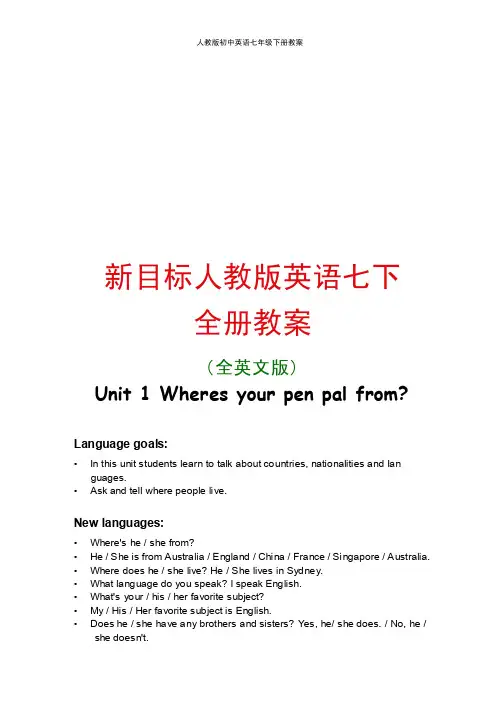
新目标人教版英语七下全册教案(全英文版)Unit 1 Wheres your pen pal from?Language goals:•In this unit students learn to talk about countries, nationalities and Ian guages.•Ask and tell where people live.New languages:•Where's he / she from?•He / She is from Australia / England / China / France / Singapore / Australia. •Where does he / she live? He / She lives in Sydney.•What language do you speak? I speak English.•What's your / his / her favorite subject?•My / His / Her favorite subject is English.•Does he / she have any brothers and sisters? Yes, he/ she does. / No, he / she doesn't.Difficult points:1. Liste ning for the in formation about cou ntries, natio nalities and Ian guages. Write an e-mail about on eself. Describe the new stude nts in class.2. Where questions with fromWhere questions with liveWhat questi onsTeaching aids:• A tape recorderTeaching periods:•Period 1:Section A 中1a, 1b, 1c•Period 2:Section A 中2a, 2b, 2c, 2d•Period 3:Section A 中3a, 3b, 4•Period 4:Section B 中1,2a, 2b, 2c•Period 5:Section B 中3a, 3b, 3c, 4•Period 6:Self CheckPeriod 1Teaching aims:1. Teach vocabulary words.2. Target Ianguages:Where's your pen pal from?He is from Australia.3. Enable the students to learn to talk about nationalities.4. Help the students learn how to talk about nationalities.Teaching procedures:Step 1. Free talk2 Say: Do you have any friends? Where is she from?Help the students make the same sentences and give them more chances to say.Step 2. Talking about the picture (1a)Hold up the picture on page 1 and point at the map. Ask students toread the picture.Ask some of you to read them aloud to the class. Make the studentstalk about where people are from.Say: Du Chuan, where is your pen pal from?Ask the students to read the conversations in the picture.Step 3. Listening (1b)Point to the numbered list of words and play the recording for a secondtime.Ask the students to listen to the recording and circle the countries in 1a.Ask students to listen to and repeat after the recording and then checkthe answers.Step 4. Pair work(1c)1. Now work in pairs and read the conversations in 1a with your partner.You can talk about your own pen pal.2. Ask the students to look at their own clothes and the things in theirbackpack. Ask and answer questions about where they are from.Homework1. Ask the students to practice talking about where people are from and make up real dialogues.2. Learn the words in this unit (on page 115) by heart.Period 2Teaching aims:1. Learn the vocabulary words and useful expressions.2. Target languages: Where does he live? He lives in Toronto.3. Let the students learn to talk about where people live.4. Help the students learn how to talk about where people live.Teaching procedures:Step I.StepI RevisionCheck the homework. And then ask several students to answer questi ons.Say: Where are you from? Do you have a pen pal? Where is your pen pal from?Step 2. Presentation (2a)Put a map of the world on the blackboard.Say: What's the meaning of capital? Can you guess? Help them to answer.Write Australia, the United States, Canada, France, and Japan on theleft of the blackboard. And write Sydney, New York, Paris, Toronto, andTokyo on the right of the blackboard. And the teacher reads them aloudand asks students to repeat.Then ask students to match the cities with the countries.Step 3. Talk about countries and citiesAsk the students to work in pairs, asking about the cities and the countries.Say: Now work in pairs and ask where the city is. For example, the firststudent asks "Where is Beijing?” the second student answers “It's inChina."Then tell the students to ask question about Chinese cities.Step 4. Listening (2b, 2c)Tell the students to read the list of countries and cities in 2a.Say: Now let's look at the list of countries and cities in Activity 2a. I will ask some students to read them aloud to the class.Call the students' attention to the chart in 2c.Tell the students to listen to the conversations in Step 4 again to complete the chart.Step 5. Pair work(2d)Ask the students to read the conversations in the bubble. Then askthem to talk about the in formation in the chart in 2c.Then ask the students to work in groups and make up new dialogueswith their own information.Step 6.GrammarfocusReview the grammar box.Say: You have to pay attention the word "from". It always follows verb be, while live comes out alone in where sentences. Now make more sentences with where, from and live.Write the following on the blackboard.Say, now work in pairs and make dialogues after the model above.Homework1. Ask the stude nts to learn the sentence patter ns in Grammar Focus by heart. Try to use them freely.2. Remember the words in this unit (on page 115).3. Make a similar dialogue according to the conversation in 2d.Period 3Teaching aims:1. Teach vocabulary words.2. Target Ianguages: What Ianguage does she speak? She speaks English.3. Enable the students to learn to talk about what Ianguage people speak.4. Help the students to learn how to talk about what language people speak.Step 1. Free talkSay, Morning, boys and girls. Nice to see you again. Do you remember we have learned about how to ask where people are from and how to ask where people live? Now I want some of you to answer my questi ons.(Turn to a student.)Where are you from?Give more students chances to speak in class.Step 2. Presentation (3a)Say: Do you know the meaning of "Ianguage"? Listen: Tim is from England and he speaks English. So English is his Ianguage. I'm fromChina, so Chinese is my language .Now look at activity 3a.on page 3.Read the instructions to the class. Ask students to work in pairs as theyanswer the questions.Show the flowing and ask the students to make conversations after themodel.Step 3. Pair work (3b)Ask the students to pay attention to the conversation in Activity 3b.Say, Read the dialogue by yourselves. Then I will ask some pairs to act out the dialogue in class.Show a map of the world. Ask students to work in pairs.Step 4. Quiz(4)Ask the students to look at activity 4 then work in pairs and do the quiz.HomeworkAsk the students to work with their friends and practice the dialogue in activity 3b.Period 4Teaching aims1. Teach vocabulary words.2. Target languages:Does she have any brothers and sisters?Is that your new pen pal?Yes, it is.3. Enable the students to learn to talk about their new pen pals.4. Help the students learn how to talk about their new pen pals.Step 1. RevisionAsk the students to make conversations talking about their new pen pal.Ask some pairs to the front to talk about their pen pals. Greet each otherand have a free talk with classmates.Talk about the persons they admire.Step 2.Match work (1)Ask the students to pay attention to the notebook page with the countries listed.Ask the students to write the letter of the correct country in the box next to the title of each Ianguage textbook on the desktop.Step 3. Listening (2a, 2b)First, read the instructions and tell the students to read the conv ersati on bubbles.Check the answers. Then ask the students to read the questions again.Ask the students to fill in the chart.Give students 1 minute to finish the task. Check the answers with the stude nts.Then play the recording again and ask the students to repeat.Step 4. Pair work (2c)Ask two students to work in pairs, practicing the questions in activity 2a.Then tell the students to practice dialogues similar to the dialogue inactivity 2a in pairs. They can use their own names.HomeworkAsk the students to make up similar dialogues using the following words: Sam, the Unites Sates, New York, a brother and a sister, English and French.Period 5Teaching aims1. Teach vocabulary words.2. Target languages:I think China is a very interesting country.I like going to the movies with my friends and playing sports.My favorite subject in school is P.E.It's fun. / It's too difficult.3. Enable the students to write a pen pal letter.4. Help the students learn how to write to a pen pal.Step 1 .Warming upSay, Do you have a pen pal? Whafs his name? Does he have any brothers and sisters? What Ianguage does he speak?Then ask the students to work in pairs to talk about their pen pal.Step 2. Reading (3a)Ask the students to read the letter on page 5.Point the four questions beneath the letter.When the students finish reading the letter, ask the four questions orally and ask them to answer orally.Ask the students to retell the letter, using their own words.Step 3. Reading and writing (3b)Ask the students to pay attention to the letter from Tom King.Point out the blanks in the letter and the information card on the right.Correct the an swers. Then draw the in formation card on the blackboard and then ask the students try to retell the letter.Step 4. WritingAsk the students make their own information card.After they are finished, ask several students to read their e-mails in class.HomeworkAsk the students to choose one of the following tasks as homework.1. Show a name card to the students and ask them to write something about it.2. The students change their information card with their partner and writesomething about their partner.Period 6Teaching aims:1. Teach vocabulary words.2. Enable the students to describe the new students in the class.3. Help the students learn to describe the new students in the class.Teaching procedures:Step 1. RevisionPractice talking about one of the students.Say, Take out your information cards. And change it with your partner.Read it carefully and make up an oral practice, talking about yourpartner.Step 2.Key word checkAsk the students to read all the words in this part.Say: In learning to talk about where people are from, you learned many words on the topic. Now read and check the words you know in 1 on page6. Then say a sentence with each of them.Step 3.Vocab-BuildersAsk students to write five new words in their Vocabulary-Builder on page 112. After they are finished, ask two students to write their words down on the blackboard. And ask them to read the words and the whole class repeat. And tell the whole class to remember them after class.Step 4.WritingLet the students pay attention to the pictures.Say, Look at the picture of Sally. How old do you think she is? Where do you think she is from? What language do you think she speaks? What do you think she likes? What do you think she dislikes?The same step goes with Jim and Julie.After a few minutes, ask some students to read their descriptions to the class.Step 5.SpeakingAsk the students to do an oral practice about the new classmates.Say, There are several new students in our class this term. Who do youlike best? Why do you like him or her? Please tell us. First you can tellyour partner.Ask some students to present their work to the class.Step 6. Just for Fun!Ask all students to read the conversation.Let the students practice in pairs.HomeworkAsk the students to summarize what they have learned in this unit and prepare for the next unit.Unit 2 Where is the post office?Language goals:•In this unit students learn to talk about asking for and give directions on the street.New languages:•Excuse me, is there a bank near here?•Yes, there is. It's on Center Street.•Where is the pay phone?•lt*s across from / next to / in front of / behind the library.•lt*s between the post office and the library.•Just go straight and tum left.•Turn left on First Avenue.•Take a walk through the park on Center Avenue.•There is a clean / dirty park near my house.Difficult points:1. Listening for the information of the names of the neighborhoodRead the tour guide and an e-mail from a friend you're going to visitWrite the dialogues about asking the way and giving directions.2. Where questions.Affirmative statementsPrepositions of placeTeaching aids:• A tape recorder•Some picturesTeaching periods:Period 1: Section A1a, 1b, 1cPeriod 2: Section A2a, 2b, 2cPeriod 3: Section A3a, 3b, 4Period 4: Section B 1a, 1b, 1c, 2a, 2b, 2cPeriod 5: Section B 3a, 3b, 3c, 4Period 6: Self CheckPeriod 1Teaching aims:1. Teach vocabulary words.2. Target Ianguages: Is there a bank near here? Yes, there is. It's on CenterStreet.3. En able the stude nts to ask for and give di recti ons on the street.4. Help the students to ask for and give directions on the street.Teaching procedures:Step 1. Warming upShow three pictures prepared before class to the students. There is acat in a box in picture 1. There is a cat on a box in picture 2. There is acat under the box in picture 3.Then ask some students to ask and answer these questions.Step 2.Match work (2a)Ask the students to read the picture and the words in the numbered list.Ask the students to match each word or phrase on the list with one of the pictures.Then check the answers.Present the new sentence patterns.Then ask the students to read the dialogue in the picture.Step 3. Listening (1b)Ask the students to listen to the conversations and circle the places in 1a.Change the roles and do the same again.Then students ask and answer without the help of the recording.Step 4. PracticePoint to the different locations shown in the picture. Ask different students to name each one.Then point to more locations and let the students to practice more.Homework1. Practice the conversation in the picture on page 7.2. Learn the new words and phrases in this period by heart.Period 2Teaching aims:1. Learn the vocabulary words and useful expressions.2. Target languages:The pay phone is across from the library.The pay phone is next to the library.The pay phone is between the post office and the library.The pay phone is on Greet Street.The pay phone is in front of the library.The pay phone is behind the library.3. Enable the students to talk about the position of a place.4. Help the students to talk about the position of a place.Teaching procedures:Step 1. Revision and warming upCheck the homework by talking about the pictures on page 7 with thestudents or prepare some other pictures with different buildings in itand let the students practice asking and answering questions about theplaces.Ask the students to practice more.Step 2. Presentation (2a)Introduce the items across from, next to, between, in front of, behind and on.Draw the following picture on the blackboard.Park 3 Centre StreetEncourage or help the students to answer: It's across from the library.The same way goes with next to, on and in front of.Ask the students to match each sentence with one of the pictures.Then ask the students to read the six sentences and match thesentences the pictures.Check the answers.Step 3. Listening(2b)Review the buildings and street names in Activity 1a and the six sentences in 2a.The read the six sentences in 2b to the class.Ask the students to listen to the recording and fill in the blanks.Play the tape. Check the answers.Step 4. Practice (2c)Ask the students to repeat the conversations after the recording.Ask the students to do the Pair work asking and answering questions about the places in 1a.Step 5.Grammar FocusAsk the students to read the sentences in the grammar box aloud. The ask them to answer the following questions. Explain some Ianguage points if the students can't understand.Homework• Ask the students to practice talking about their neighborhood in pairs.Period 3Teaching aims:1. Teach vocabulary words.2. Target Ianguages:Just go straight and turn left.It*s down Bridge Street on the right.Ifs next to a supermarket.3. Enable the students to talk about the neighborhood.4. Help the students to talk about the neighborhood.Teaching procedures:Step 1. RevisionLet the students look at the picture in activity 1a. And ask some studentsto answer some questions in order to check the homework.Say, Is there a library near here? Where is it? Is there a bank near here?Where is it?Put up the picture of activity 2a on the blackboard and ask them to makeconversations.Step 2. Presentation (3a)Guide the students to guess the meanings of the three traffic signs. Show the pictures and ask some questions about the pictures.Then ask the students to hold up their left hands and then their right hands to practice “left” and "right".Point to the picture and let the students read the conversation.Ask the students to read the conversations. Then ask them to find Paul and Nancy in the picture.Ask the students to role play the conversation then point out the place that Paul wants to get to.Step 3. Complete the conversations (3b)Ask the students to make conversations and answer the questionsbelow each picture.The students point out the place in the picture. And write down theanswers on the line in the pictures. Or ask a pair of students to say theconversation, the others point to the speakers' place.Step 4. GameAsk the students to look at the picture in Activity 1a and name all thebuildi ngs.Ask some students to read the conversation in the picture in Activity 4.And then explain the instruction to the student.Then ask some groups to present their work.Homework• Ask the students to make a similar conversation to that in Activity 3a.Period 4Teaching aims:1. Teach vocabulary words.2. Target languages:Is there a big supermarket near your house?Yes, there is.There is a big supermarket.No! There is a small supermarket.3. Enable the students to describe the neighborhood.4. Help the students to describe the neighborhood.Teaching procedures:Step 1. RevisionCheck the homework by asking the following questions.Say, Look at the picture in activity 3a. Suppose you are standing nearthe building on the side of New Street. Please answer my questions.Excuse me. Is there a pay phone in the neighborhood?Ask another student to answer questions.Give more students chances to practice this dialogue.Step 2.Match work (1a)Bring in some objects or pictures to the students. (Two rulers, one is old, the other is new. Two boxes, one is big and the other is small. Two bottles, one is clean and the other is dirty. Two pictures of a street, one is busy and the other is quiet.)Say, Look at the rulers, please. Can you find the differenee between them?Yes. This one is old. (Show the old ruler.) And this one is new. (Show the new ruler.) Do you understand old and new?Ask the students to talk about the picture.Point to each half of each picture and ask about the differenee between the halves.Go on with the other pictures to teach the language items. Ask thestudents to match the words with the pictures.Step 3. Pair workCall attention to the conversation in the picture.Then ask the students to work in pairs and take turns asking each other questions about the things on the list of phrases in activity 1a on page 7.Step 4. Listening (2a, 2b)Ask the students to listen to the tape and circle the places in 1a.Say: Now please listen to the tape again. Listen to it and draw the places in Michael's neighborhood on the street map. Just listen.Play the recording.Play the recording again.Then have some students show their completed drawing to the class. Step 5. Pair workAsk the students to work in pairs talking about drawings to the class. Then ask some pairs to present their dialogues to the class.Ask the students to work in pairs, draw a map of their own neighborhood and practice asking and answering questions about the places they live in.Homework• Ask the students to make similar conversations to that in Activity 1 b.Period 5Teaching aims:1. Teach vocabulary words.2. Target languages:Turn left on First Avenue and enjoy the city's quiet streets and small parks.Take a walk through the park on Center Avenue.This is the beginning of the garden tour.Bridge is a good place to have fun.3. Enable the students to write a tour guide and draw the rout to somewhere.4. How to write a tour guide and draw the rout to somewhere.Teaching procedures:Step 1. RevisionCheck the homework by asking about the students neighborhood.Ask the students to work in pairs.Ask the students to work in pairs.Then ask some pairs to present their conversations to the whole class. Step 2. Reading (3a, 3b)Ask the students to read the tour guide.Divide the whole class into four groups to have a quiz.Tell the students to keep these words down and make at least twosentences with each word after class.After that ask the students to look at the pictures and fill in the blanks for this tour guide.Step 3.WritingAsk the students to write a tour guide with the students.Names of buildings and locations.Description wordsWords that talk about positions.Words that talk about di recti ons.Step 4. Pair work (4b)Learn to draw a picture of neighborhood. First ask the students toanswer the questions according to the pictures.Then ask the students to draw a picture according to the following conversati on.Then ask students to present their drawings to the whole class.Homework1. Ask the students to talk about the street and buildings in their own neighborhood.2. Ask the students to make sentences with the description words they keptdown in the class.Period 6Teaching aims1. Teach vocabulary words.2. Target Ianguages:I know you are arrivi ng n ext Sun day.Let me tell you the way to my house.I hope you have a good trip.3. Enable the students to write about the neighborhood.4. Help the students to learn how to write about the neighborhood.Teaching procedures:Step 1. RevisionCheck the homework by asking and answering some questions.Give more students chances to practice.Step 2.Key word check(1)Ask the students to check the words they know.Then ask the students to do the some exercises.Step 3.Vocab-Builders (2)Expand the students' vocabulary.After that ask the students to share their list with other students.Step 4. ReadingAsk the students to read the letter and draw the rout on the map.Ask the students to change the letter into a telephone conversation.Let the students pay attention to the pictures.Say, Look at the picture of Sally. How old do you think she is? Where do you think she is from? What language do you think she speaks? What do you think she likes?What do you think she dislikes?The same step goes with Jim and Julie.After a few minutes, ask some students to read their descriptions to the class.Step 5. Just for Fun!Call attention to the conversation in the cartoons.Ask the students to read the conversation and then answer the questi ons.Homework• Ask the students to do the following:1. Suppose your frie nd is going to visit you. He does n't know the way toyour house. Write a letter to him to tell him the route from the bus stop to your house.2. Review the next unit.Unit 3 Why do you like koalas?Language goals:•In this unit students learn to describe animals and express preferences.New languages:•Let's see the pandas first.•Why do you like want to see the pan das?•Because they are very cute.•Because they*re kind of shy.•Because they're kind of interesting.•Because they are fun.•Because they are smart.•Do you like giraffes?•Where are lions from?•They are from South Africa.•The animal is ugly / beautiful / friendly / small / shy / clever / cute / scary. •She likes to play with her friends and eat grass.•She's very beautiful, but she's very shy, so please be quiet•He sleeps during the day, but at night he gets up and eats leaves.Difficult points:1. Listening for the names of animals. Listen for the description words about animals.2. Read the description words about animals. Write about the animal you know.3. why, what, where questions, because, adjectives of qualityTeaching aids:• A tape recorder•Some picturesTeaching periods:•Period 1: Section A1a, 1b, 1c•Period 2: Section A2a, 2b, 2c•Period 3: Section A3a, 3b, 4•Period 4: Section B 1a, 1b, 1c, 2a, 2b, 2c•Period 5: Section B 3a, 3b, 3c, 4• Period 6: Self CheckPeriod 1Teaching aims:1. Teach vocabulary words.2. Target languages:Let's see the pan das.Why do you want to see the lions?Because they*re cute.3. Enable the students to talk about animals.4. Help the students learn how to listen to and talk about animals.Teaching procedures:Step 1. Warming upTalk about animals using pictures.Teach new words about animals by the pictures.Step 2.Match work (1a)Ask the students to read the words and the picture, and then match thenames with the pictures a-h.Encourage or help the students to say something about the picture anddo the match work.Step 3. Listening (1b)Point to the numbered list of words in activity 1a and play the recording.Ask the students to listen to the recording and circle the countries in 1a.Play the tape and then check the answers.Ask the students to listen to and repeat after the recording and thencheck the answers.Further activity: Ask the students to do some pair work in the followingway if they can understand the listening material well.Step 4. Pair work (1c)Ask the students to make conversations in pairs.Show the following.—Let's see the pan das / giraffes / lions / penguins / dolphi ns / koalas / elepha nts / tigers?—Why?——Because they're cute / interesting / fun / interesting / smart.Say: Now please make conversations in pairs, using the animals in activity 1a and the description words in activity 1c.Homework1. Ask the students to remember the new words in this period (on page 116) by heart.2. Ask the students to practice the conversation in activity 1 c.Period 2Teaching aims:1. Learn the vocabulary words and useful expressions.2. Target languages:I like dolphins.Why do you like dolphins?Because they are kind of interesting.3. Enable the students to talk about animals and tell why they like them.4. Help the students learn to talk about animals and tell why they like them. Teachi ng procedures:Step 1. Free talk and lead-inRevise the names of the animals.Say: In last period we learnt the names of some animals. Now let's do some revision. Please look at the pictures one by one and you have to tell me the name of the animal in the picture. OK?Show the students the animal pictures one by one.Revise the conversation learnt in the last period.Give more chances to more students to practice talking about the animals and expressing why they like the animals.Step 2. Listening (2a, 2b)First ask the students to listen and fill in the chart in activity 2a.Play the recording for the first time. Ask the students to listen carefully and write down the animals.Play the tape the second time.Ask the students to pay attention to the words in the box in Activity 2b.Ask the students to pay attention to the conversation in activity 2b. After that, check the answers.Then ask the students to listen to and repeat the dialogue after therecording.After this, ask the students to practice the conversation without the help of the recording.Step 3. Pair work (2c)Ask the students to work in pairs, ask and answer about animals they know.Ask the students to practice: Why? Because they are...Step 4.GrammarfocusAsk the students to read the sentences in the grammar box and sum up the sentence structure.Practice suggest!on: Ask the students to work in groups and write down。

初中英语教案(初中英语教案(优秀8篇)教案是教师课堂教学过程中的重要依据,是教师对于教材的主观理解和感悟,是教学活动正常开展的重要保障。
以下是人见人爱的我分享的8篇《初中英语教案(初中英语教案》,如果能帮助到您,小编将不胜荣幸。
初中优秀英语教案篇一一、教学内容分析本单元是人教版《新目标》七年级下册第四单元。
这本教材的词汇量很大,内容新颖,尤其是生动活泼的卡通化的画面,很符合七年级学生的年龄特点和心理特点,其中还囊括了很丰富多彩的文化知识,以及合作探究的活动,十分贴近学生的`实际生活经验。
因此,本单元对于提升学生的学习兴趣而提高学生的听、说、读、写能力有很大的帮助。
并通过self?check检测,积极地、及时地寻找各自的不足,以便学生树立良好的内在动机,不断获得成就感。
二、教学背景分析?本单元的话题Talk?about?rules.与日常生活密切相关。
作为一名中学生,遵守学校班级、家庭和社会公共场所的规章制度是必须的。
在谈论规则时,一般运用祈使句、情态动词can和have?to等。
这是英语新课程标准中规定所必须掌握的内容,是交际英语中必不可少的项目。
三、教学设计说明本课通过不同种类的规则,谈论学生应该遵循那些规则,主要是应用祈使句、情态动词can和have?to等,可以说,本节新课是对这一语法的具体操练。
本课使用多媒体课件教学,用不同类型的规则和地点图片来吸引学生,激发学生学习的积极性。
四、教学过程Step 1 Warming?up and revision1、教师进入教室后,使用祈使句要求学生们完成一系列动作:Please stand up/sit down.Close the door, please.Look at me and listen to me.Dont open your books.Dont talk.Lets begin our class.(The teacher can also write down these sentences on the blackboard, and then let students find the characters of Imperative Sentences by themselves.)2.Show some pictures and lead in to the new words with the pictures:hallway classroom dinning hall fight arrive listen to…Step 2 Presentation1.Show the picture in 1a, and ask the students:(Point to the running boy)T: Whats the boy doing?S: Hes running.T: Where is he running?S: Hes running in the hallways.T: Can you run in the hallways?S: No, we cant.T: So please dont run in the hallways.(=You cant run in the hallways.)(板书、教读)学生跟读数遍,明白祈使句和“can”表达的含义。
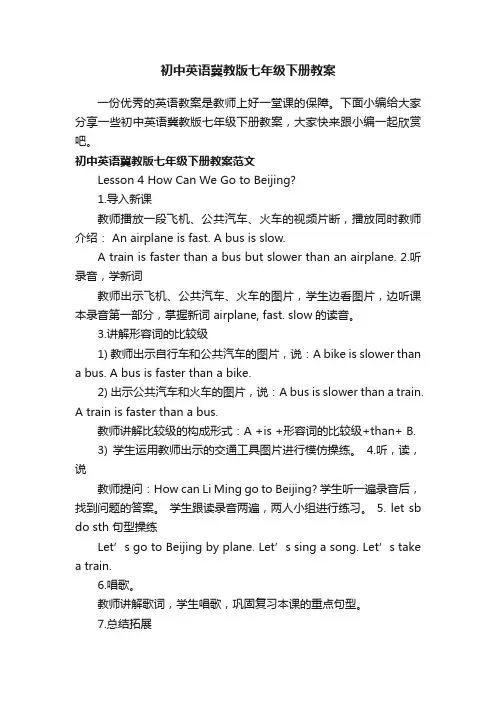
初中英语冀教版七年级下册教案一份优秀的英语教案是教师上好一堂课的保障。
下面小编给大家分享一些初中英语冀教版七年级下册教案,大家快来跟小编一起欣赏吧。
初中英语冀教版七年级下册教案范文Lesson 4 How Can We Go to Beijing?1.导入新课教师播放一段飞机、公共汽车、火车的视频片断,播放同时教师介绍: An airplane is fast. A bus is slow.A train is faster than a bus but slower than an airplane. 2.听录音,学新词教师出示飞机、公共汽车、火车的图片,学生边看图片,边听课本录音第一部分,掌握新词 airplane, fast. slow的读音。
3.讲解形容词的比较级1) 教师出示自行车和公共汽车的图片,说:A bike is slower thana bus. A bus is faster than a bike.2) 出示公共汽车和火车的图片,说:A bus is slower than a train.A train is faster than a bus.教师讲解比较级的构成形式:A +is +形容词的比较级+than+ B.3) 学生运用教师出示的交通工具图片进行模仿操练。
4.听,读,说教师提问:How can Li Ming go to Beijing? 学生听一遍录音后,找到问题的答案。
学生跟读录音两遍,两人小组进行练习。
5. let sb do sth 句型操练Let’s go to Beijing by plane. Let’s sing a song. Let’s takea train.6.唱歌。
教师讲解歌词,学生唱歌,巩固复习本课的重点句型。
7.总结拓展总结本课重点短语和句型。
8.随堂测试Lesson 5 Leaving and arriving1.复习请两组同学表演 Lesson 4 , Part2。
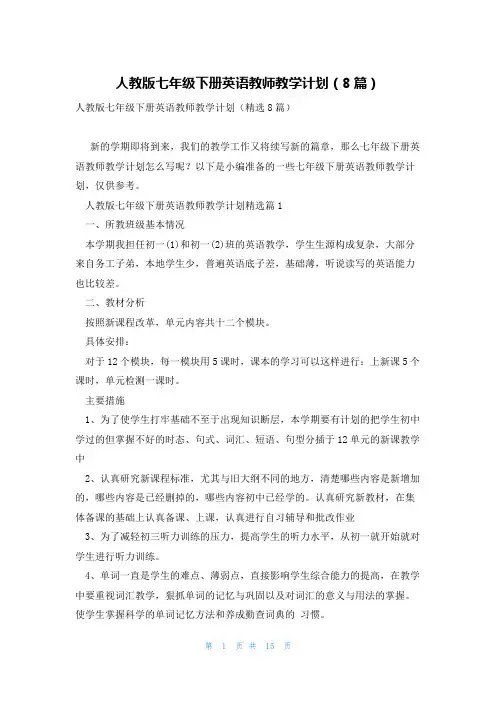
人教版七年级下册英语教师教学计划(8篇)人教版七年级下册英语教师教学计划(精选8篇)新的学期即将到来,我们的教学工作又将续写新的篇章,那么七年级下册英语教师教学计划怎么写呢?以下是小编准备的一些七年级下册英语教师教学计划,仅供参考。
人教版七年级下册英语教师教学计划精选篇1一、所教班级基本情况本学期我担任初一(1)和初一(2)班的英语教学,学生生源构成复杂,大部分来自务工子弟,本地学生少,普遍英语底子差,基础薄,听说读写的英语能力也比较差。
二、教材分析按照新课程改革,单元内容共十二个模块。
具体安排:对于12个模块,每一模块用5课时,课本的学习可以这样进行:上新课5个课时,单元检测一课时。
主要措施1、为了使学生打牢基础不至于出现知识断层,本学期要有计划的把学生初中学过的但掌握不好的时态、句式、词汇、短语、句型分插于12单元的新课教学中2、认真研究新课程标准,尤其与旧大纲不同的地方,清楚哪些内容是新增加的,哪些内容是已经删掉的,哪些内容初中已经学的。
认真研究新教材,在集体备课的基础上认真备课、上课,认真进行自习辅导和批改作业3、为了减轻初三听力训练的压力,提高学生的听力水平,从初一就开始就对学生进行听力训练。
4、单词一直是学生的难点、薄弱点,直接影响学生综合能力的提高,在教学中要重视词汇教学,狠抓单词的记忆与巩固以及对词汇的意义与用法的掌握。
使学生掌握科学的单词记忆方法和养成勤查词典的习惯。
5、坚持每周一次作文训练,训练题材、方法力求多样化,并能及时进行讲评。
鼓励学生写英文日记,对个别英语特差的学生尽量多批改、多指导。
6、阅读理解能力的培养是初中教学的重点,也是中考的重头戏。
在单元教学中专门抽出一节课作为阅读课,材料为课外五篇课外阅读理解,并且有计划的指导学生掌握科学的阅读方法。
7、集体备课是提高教学质量和整体教学水平的有力保证,有利于经验丰富的教师与年轻教师互为补充、共同提高。
坚持集体备课,集体备课前先确立一名中心发言人,由中心发言人先确定下周所教单元的重点、然后全组人员共同探讨,最后确定下来。

人教版七年级英语下册教学计划5篇人教版七年级英语下册教学计划5篇1一、指导思想认真学习新课程教学大纲和全册教材。
明确教学任务和教材体系,把握重点单元和章节,在此基础上制订全学期授课计划。
掌握教材的教育因素和知识点,根据教材和学生的实际,确定重点难点,明确德育渗透,双基训练、智能培养等各项教学目标,精心设计教学程序,选定最佳教学方法。
端正教育思想,全面贯彻教育方针,努力探索教学规律,遵循教学原则,积极推进素质教育。
二、教学目标在新课程理论的指导下,我将以学校教育处和英语教研组工作计划为指导,积极听课,加强课堂教学,高效地完成本学期英语教学目标。
并积极参加教科研活动,加强理论学习,努力使自身的教学水平、业务本事有更大的提高。
同时,经过传授与学生生活密切联系的英语知识,训练英语的听说本事,培养学生学习英语的兴趣和运用英语的本事,最终使学生从“学会英语”向“会用英语”发展。
三、学情分析本学期我担任七年级(5)、(6)班的英语教学工作,七(5)班共有学生57人,男生33个,女生24个。
七(6)班有学生57人,男生32个,女生25个。
在这些学生中,两个班均是男生人数大于女生,学生英语基础知识和听说本事水平不一,大部分学生虽然在小学接触过英语,但应用本事十分薄弱,听力题,大部分学生听起来都很吃力。
应对学生掌握英语的程度不一,我将采用高效课堂模式,分层教学与整体教学相结合的方式完成教学任务,努力提高他们的英语水平。
另外,两班学生在情感态度、学习策略和文化意识方面还存在诸多需要进一步解决的问题。
例如:个别学生不明确学习英语的目的;有些同学对学好英语缺乏自信,不敢用英语表达;缺乏小组合作意识;一些学生没养成良好的学习习惯,不能做好课前预习课后复习,学习没有计划性和策略性;不善于发现和总结语言规律,不注意知识的巩固和积累。
所以,现阶段最重要的是激发学生学习英语的兴趣和积极性,帮忙他们增强信心,克服困难。
除了从思想上给予引导之外,更重要的是在教学上,有针对性、目的性、有系统、有计划地上好课。
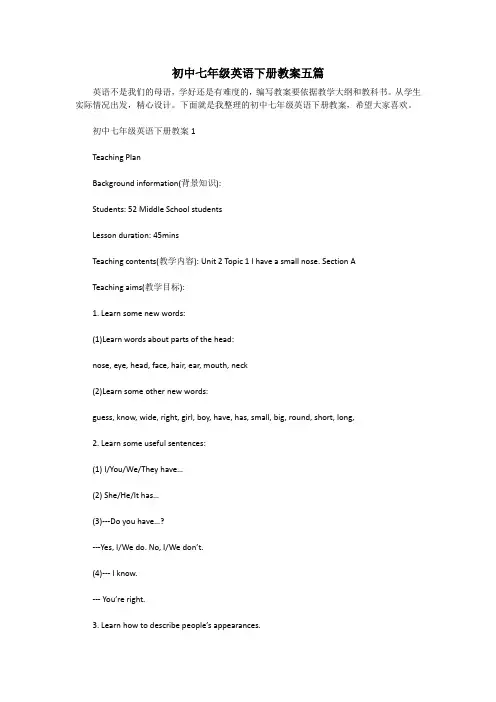
初中七年级英语下册教案五篇英语不是我们的母语,学好还是有难度的,编写教案要依据教学大纲和教科书。
从学生实际情况出发,精心设计。
下面就是我整理的初中七年级英语下册教案,希望大家喜欢。
初中七年级英语下册教案1Teaching PlanBackground information(背景知识):Students: 52 Middle School studentsLesson duration: 45minsTeaching contents(教学内容): Unit 2 Topic 1 I have a small nose. Section ATeaching aims(教学目标):1. Learn some new words:(1)Learn words about parts of the head:nose, eye, head, face, hair, ear, mouth, neck(2)Learn some other new words:guess, know, wide, right, girl, boy, have, has, small, big, round, short, long,2. Learn some useful sentences:(1) I/You/We/They have…(2) She/He/It has…(3)---Do you have…?---Yes, I/We do. No, I/We don’t.(4)--- I know.--- You’re right.3. Learn how to describe people’s appearances.Teaching focus(重点):words about parts of the head and adjectives of description Teaching difficulties(难点):The usages of have and hasTeaching procedures:(教学步骤)Step1 Warm-up 第一步热身greetingsing a song : Head and shoulders.Step2 Review 第二步复习(1) 通过复习,培养学生根据卡片信息进行简单交流的能力。
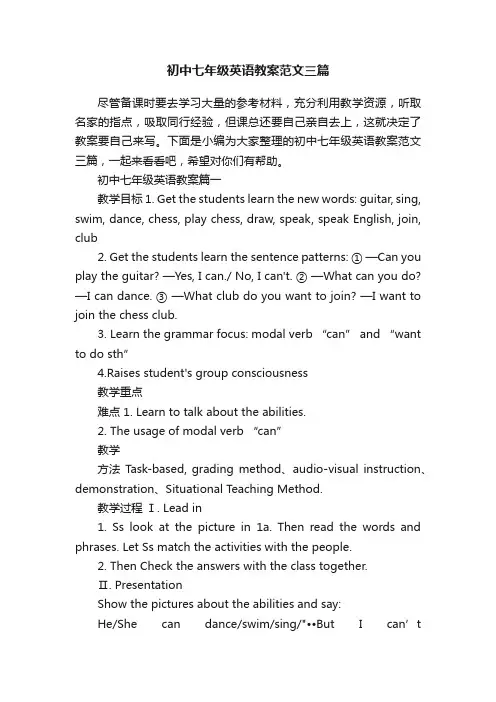
初中七年级英语教案范文三篇尽管备课时要去学习大量的参考材料,充分利用教学资源,听取名家的指点,吸取同行经验,但课总还要自己亲自去上,这就决定了教案要自己来写。
下面是小编为大家整理的初中七年级英语教案范文三篇,一起来看看吧,希望对你们有帮助。
初中七年级英语教案篇一教学目标 1. Get the students learn the new words: guitar, sing, swim, dance, chess, play chess, draw, speak, speak English, join, club2. Get the students learn the sentence patterns: ① —Can you play the guitar? —Yes, I can./ No, I can't. ② —What can you do? —I ca n dance. ③ —What club do you want to join? —I want to join the chess club.3. Learn the grammar focus: modal verb “can” and “want to do sth”4.Raises student's group consciousness教学重点难点 1. Learn to talk about the abilities.2. The usage of modal verb “can”教学方法Task-based, grading method、audio-visual instruction、demonstration、Situational Teaching Method.教学过程Ⅰ. Lead in1. Ss look at the picture in 1a. Then read the words and phrases. Let Ss match the activities with the people.2. Then Check the answers with the class together.Ⅱ. PresentationShow the pictures about the abilities and say:He/She can dance/swim/sing/"••But I can’tdance/swim/sing/...Ⅲ. Game (What can I do?)T: Tell your partners what you can do. For example:I can play the guitar. I can sing and dance.Ss work in groups. The let some Ss talk to their classmates in front of the class.Ⅳ. Listening1. T: Now let’s listen to the tape, find out the right conversation, and number them 1-3.2. Check the answers: (3, 2, 1 )Ⅴ. Pair work1. Ask the Ss to practice the conversations in 1b with a partner. Then make their own conversations. Ⅵ. Listening1. Work on 2a;T: Now, look at the pictures on P2, listen to the four conversations. Just listen.(Play the recording for the first time, students only listen carefully.)Then, listen to the recording again, and circle the clubs you hear.Check the answers with the class.2. Work on 2b;3. Check the answers with the Ss.Ⅶ. Pair work1. Look at 2b and talk about what the people can do and the clubs they want to join.T: What club does Lisa want to join?S1: She wants to join the chess club.T: Can she play chess?S1: No, she can't.2. Ss work in pairs to practice asking and answer about Lisa, Bob and Mary.3. Ask some pairs to act out their conversations.Ⅷ.Homework:1. Remember the new words and expressions after class.2. Recite the conversation after class.3. Write English names as many as possible in the exercises book.Ⅸ.Blackboard design Section A 1 (1a-2d)Drills:1. —Can you sing? —Yes, I can./No, I can't.2. 2b: 1. chess, chess 2. English; English3. sing, dance, music4. ① What club does Bob join?② What club does Jane join?5. want to do sthThey want to have some rice and vegetables.初中七年级英语教案篇二第一单元备课教案一、语言知识与技能1.根据读音规则和音标拼读单词。
英语初一下册教学设计五篇教学过程,实际上是学生在教师指导下的认识过程。
学生是认识的主体,知识的掌握和潜力的培养只能在主体自己相应的用心自觉活动中才能构成。
下面是小编整理的英语初一下册教学设计5篇,欢迎大家阅读分享借鉴,希望大家喜欢,也希望对大家有所帮助。
英语初一下册教学设计1Unit 8 I’d like some noodles.I. Analysis of the T eaching Material1. Status and functionThe topic of this unit is about food. The students will learn how to order food ortake-away. In this unit, the students will be able to use “would like” to express their needfor food and learn how to ask others‟information and provide their personal informationduring the process.2. Teaching aims and demands1). Knowledge objectsa. To master how to order food or take-away;b. To master the modal verb “would” and “what” questions.c. To master the usage of countable nouns and uncountable nouns.2). Ability objectsd. To use “would like” to talk about the need for food.e. To improve students‟ ability of communication and social practice.3). Sensibility objects:Let the students experience the happiness of learning English,cultivate their abilityto do things and foster the spirit of cooperation in group activities.3. Teaching difficult points and focus:1)To learn the names of food and the countable and uncountable nouns.2)To learn how to order food.3)To use “would like” to express their need for food and learn how to order food.II. Target Language1) what would you/he/they like to eat?I‟d /He‟d /They‟d like some...2) What kind of noodles would you/he/they like?I‟d/He‟d /They‟d like beef and tomato noodlesIV. Vocabularynoodles, beef, chicken, mutton, potatoes, tomato, cabbage,carrot, dumplings, porridge, soup, green tea, orange juice, would like…V. Teaching Time45 minutesVI. Teaching ProceduresStep 1. Warm up.1) Show some pictures about sports and let the students answer the questions below:After doing these sports, what‟s your feeling?Are you tired ?Are you hungry?2) Let the students thinking the question: If you are hungry, what would you like to eat?3) Show some pictures of food that they have learned.Step 2. Lead into.1)T: “No food left! But don‟t worry, let‟s go to the restaurant to have a big meal.Look! What can you see in the restaurant?Yes, There are many kinds of food there. You can choose whatever you like”.2)Show the new words.3)Questions:A: What kind of vegetables/meat/food/drink would you like?B: I‟d like some…Let the students to learn the names of food and the countable and uncountable nouns. Let the students make some dialogue.Step 3. Let’s chant.Step 4. Noodle House.1) Show some pictures about noodle specials.meat+vegetables → special1/special2….(let the students to guess the meaning of the word …special ‟)2) Make dialogueA: What kind of noodles would you like?B: I‟d like…and…noodles.Step 5. Pairwork and guessing game1) Pairwork . (Make dialogues.)2) Game: Who is the winner?Ask a boy and a girl come before the blackboard, and then ask two students to make adialogues. The boy or the girl who find the right special will win one score….aftersome pairwork, see who is the winner? The boy or the girl.3) Guessing game.Step 6. Role Play (In the Nodle House)A customer and a waiter. (Make a dialogue)Let the students express their need for food and learn how to order food.Step 7. SummaryStep 8. ApothegmStep 9 A Flash → “I’m hungry”英语初一下册教学设计2课前准备教师:准备游戏时所用的图片(食物、蔬菜、动物)。
Unit4 SectionA(Grammar Focus3c)参考教案一、教学目标:1. 语言知识目标:词汇学习:掌握新词汇sugar, cheese, popcorn, corn, machine, dig, hole,并复习Section A中的相关词汇。
语法运用:进一步巩固和应用如何用how much和how many来询问事物的数量。
过程描述:能够流畅地使用英语描述制作爆米花的简单过程,并正确使用表示顺序的词汇。
2. 情感态度价值观目标:生活技能培养:通过学习制作爆米花,增强学生的实践操作能力,并了解相关的生活知识。
珍惜劳动成果:让学生认识到制作食物的艰辛,从而懂得珍惜食物,不浪费。
二、教学重难点1. 教学重点:词汇与词组的运用:确保学生能够熟练运用Section A中的词汇和本课的新词汇。
数量提问的掌握:学生能够自如地使用how much和how many来询问食物的数量。
2. 教学难点:过程描述的准确性:能够清晰、准确地描述爆米花的制作过程,包括各个步骤和所需的材料。
名词的可数与不可数:学生能够正确区分可数名词与不可数名词,并会用适当的数量词来描述不可数名三、教学过程Ⅰ. Warming up and revisionGame: How do you make a banana milk shake?Teacher: Let's play a game. We're going to learn how to make a banana milk shake. Who wants to describe the steps first?Student 1: First, you peel the banana.Teacher: Great! Next?Student 2: Next, you put the banana into the blender.Teacher: And then?Student 3: Then, you pour the milk into the blender.Teacher: Finally?Student 4: Finally, you turn on the blender and mix it well.Teacher: Very good! Remember to use "first, next, then, finally" correctly when describing processes.How do you make a Russian soup?Teacher: Now, let's try with a different recipe. How do you make a Russian soup? Student 5: First, you heat the water.Teacher: And?Student 6: Next, you add the vegetables and meat.Teacher: Continue...Student 7: Then, you let it boil for a while.Teacher: And finally?Student 8: Finally, you add salt and pepper to taste, and serve it hot.Teacher: Excellent! Remember, using "first, next, then, finally" helps make instructions clear and easy to follow.Ⅱ. Grammar Focus.1. 学生阅读Grammar Focus中的句子,然后做填空练习。
Unit 1 Where’s your pen pal from?一、单元教材分析本单元的中心话题是pen pals。
主要语言功能项目是talk about countries, cities and languages。
语法结构为Where…from; Where…live and what language…speak。
先以Activity1复习语言与国家的配对练习入手,Activity2a, 2b一个综合的听力训练来展示学生的听力能力,并以听力内容为基础,通过Activity2c中假设的两人对话操练来培养学生的交流能力,同时也引导学生多沟通与多交流。
Activity3a是一篇email形式的阅读文章,并有相关问题由学生在阅读后进行回答Activity3b 是根据提供的信息进行填空的写作练习,Activity3c 是一篇模仿写作,让学生给自己的笔友写一封关于本人信息的email。
我在各课时教学中设计各种各样的小活动,通过Discussion,Classifying,Guessing等不同方式让学生掌握本单元的知识点,用学会的知识与外国的笔友自如的交谈是学习本单元的目的。
二、教学目标分析1、语言目标a. 重点词汇:Countries: Canada, China, France, Japan, the United States, Singapore, Australia,The United Kingdom, Paris.Cities: Sydney, New York, Toronto, Toyo, LondonLanguages: English, French, Japanese, Chinese.b. 重点句型:-Where…from? -She’s/He’s from…-Where does…live? -She/He lives in …-What language does she /he speak? -She/He speaks ….2、能力目标a. 培养学生在文段中寻找信息的能力;b. 学会用英文给笔友写回信,简单介绍个人情况;c. 通过有效地小组合作,培养学生合作能力及团队精神。
初中英语人教版七年级下册复习课教案备导日期:2016年3月14日设计者:XXX执教:XXX课题:Review of Unit6-7(Book7B)I am watching TV。
& It is raining.1.会读并熟记本单元重点词汇,短语,句型。
研究目标2.掌握现在进行时,并能运用现在进行时描述正在发生的事情。
3.通过谈论现阶段的研究及生活,相互鼓励,努力研究,迎接中考。
研究重点研究难点运用现在进行时描述正在发生的事情。
现在进行时表示当前一段时间内的活动或现阶段正在进行的动作。
导学过程及内容Step1Self studyXXX 1.XXX XXX.1.看电视______________2.看报纸______________3.讲电话______________4.听CD______________5.使用电脑______________6.做汤______________7.洗碟子______________8.运动______________9.听起来______________10.有点儿______________11.做粽子______________12.捎个口信______________13.度假______________14.玩的愉快______________15.我的百口福______________16.在泅水池中间______________17.right now______________18.外出用饭_____________19.你正在做甚么?20.我正在看电视。
__________________________________________________ ________________21.她正在做什么?22.她正在洗衣服。
__________________________________________________ ________________23.他正在看报纸吗?24.是的,他正在看报纸。
最新人教新目标七年级英语下册全英文教案(全册全英文)Unit 1 Can you play the guitar?教学过程♦ Step 4 Role-play1.Ask the students to read the conversation in 2d.try to find: What can Jane/ Bob do?What club do they want to join?2.Ask the students to fill in the forni.(见课件)3.Ask students to practice the conversation according to the for m・4.Ask students to perform the conversation.♦Step 5 Explain several important words and phrases.(见课件)♦Step 6 HomeworkMake a survey about what your friends can do and what club your friends want to join. 板书设计Unit 1 Can you play the guitar教学过程Example:In my group,Li Lin can do kung fii.Liu Kun can tell stories....Fm sure we will give you a good show and make you have a good time・♦ Step 6 HomeworkWrite an ad—Students Wanted for Our Learning Group・板书设计Unit 1 Can you play the guitar4.Ask students to read the passages in 2b.And then match the titles with the ads・5.Check the answers・6.Who fits the job? Match each person in 2a with an ad in 2b.Write A.B and C.(见・课件)7.Check the answers・♦Step 5 Explain important points.♦Step 6 HomeworkWrite a letter to your. teacher.Tell him/lier what you can do for school concert・板书设计课堂练习I •根据汉语意思完成句子1.你能帮我学英语吗?____ you help me ________ English?2.你善于和老人相处吗?____ you ______________ old people?Unit 1 Can you play the guitar(3)hclp⑷be good at/witli/for的用法与区分Work on Self Check 3Ask several students to show their works.♦ Step 5 HomeworkWrite a poster:Artist Wanted for Art Festival.板书设计课堂练习I •单项选择1 ・ Peter __ play soccer・A.can alsoB.also canC.can tooD.too can2.___ you good ______ c hildren?A.Are;forB.Is;in.C.Are;atD.Are;with3.Please call Mr.White ____ 589-267.A.inB.atC.onD.with4.― an you sing or swim?A.YesJ can swimB.NoJ can't swimC.YesJ can singD.I can sing5.___________________________ We want two good actors our school show.Unit 2 What time do you go to school?Keys:(l )From 12:00 at night to 6:00 in the morning. (2)At eight thirty at night. (3) At nine. (4) At ten twenty.(5) At elev亡n o'clock.3.Ask students to practice the conversation in 2d in pairs.教学过程板书设计课堂练习I .根据句意及首字母提示完成单词I・一What t _ da you go to school?—At &00.2.1usually get u ____ at 7:00 every day.What about you?3.__________________________________ My mother bought me two red d on my birthday.4.1need a new b _____ and some new pencils to draw the picture・5.1usually take a s ____ before I go to bed・Keys: 1.time 2.up 3.dresses 4.brush 5.showcrII.用所给词的适当形式填空1. A man has twenty-eight ______ (tooth)・2.Mrs.Li _____ (dress) little Tom every morning.3.My father ______ (work) in a shoe factory.4.Mr.Wang tells us a _____ (fun) story in class.5.1do morning ______ (exercise) with my grandparents every day.Unit 2 What time do you go to school♦Step 2 Learning Grammar Focus1.Ask students to read the sentences in Grammar Focus and translate them into Chinese.,2.Explain several important points・3.Ask students to do some exercises.(见课件)♦Step 3 Writing sentences1 .Work on 3a.Ask the students to write answers or e always,usually or never.2.Ask the students to show the answers.3.Let students write something they always/usually/never do on the blackboard・4.Ask students to do an interview with three students.Find out what time they do the activities in 3c.Then give a report. For example:In our group.Li Fei usually gets up late on weekends.She gets up at...♦Step 4 Explain several important words and phrases.(见课件)♦Step 6 HomeworkWrite an article to mtrodnee your classmate's daily activities.板书设计课堂练习I .根据句意及汉语提示写单词1 .This is a big train (火车)(站)・2.Lily ____ (从不)buys green clothes.3.You don't need to go to school ______ (早地)next Monday.4.The _____ (收音M) player is very nice・5.We have lunch at twelve _______ (点钟).Unit 2 What time do you go to school教学过程♦Step 4 Explain several important points.♦Step 5 HomeworkWrite a passage about your daily life.板书设计课堂练习I .单项选择I.Can you help us do _____ ?A.our homeworksB.our homework homeworks homework2.We go home at half _____ five ______ t he aftemoon.A.to;inB.past;atC.to;atD.past;in3.What time do you eat _____ breakfast? What do you usually have _______ breakfast?A./;/B.for;forC./;forD.for74.1 like to eat __ apples _____ pears.but not grapes・A.either;orB.neither;norC.not only;butD.or;or5.____________ The cake good.I w^nt another one・A.feelsB.tastesC.soundsD.feelsKeys:l—5BDCABII•根据汉语意思完成句子Unit 2 What time do you go to schoolUnit 3 How do you get to school教学过程♦ Step 4 Work on 2dStudent A is Jane and Student B is e the information in 2b to make conversations.A:How do you get to school?B:L・・A:How long does it take...?B:It takes...A:How far is it from...to...?Bit's about...♦Step 5 ReadingAsk students to read the dialogue in 2e and translate it into Chinese.Then ask students to role-play the dialogue. ♦Step 6 HomeworkPractice the conversation in 2c.板书设计课堂练习1.根据句意及汉语提示写单词1 Jim is not happy because he lost his _____ (自行车).2.There are always lots of people on the _____ (公共汽车).3.My aunt takes the ____ (地铁)to work every day.4.—How do you get to Beijing?—I take the ____ (火车).5.1 usually _____ (步行)to school in the morning・Keys: 1.bike 2.bus 3.subway 4.train 5.walkUnit 3 How do you get to school教学过程♦ Step 4 Make a survey 3cl.Show a chart on the screen.(2.Let students ask their classmates questions and write their names in the chart.The firs4 student to fill in all the blanks wins.3.Ask several students to show their results in front of the class・板书设计课堂练习I •单项选择l.____________ How far is from Hangzhou to Wuhan?A.thatB./C.itUnit 3 How do you get to school教学过程4.Check the answers.(见课件)①They go on a ropeway to cross the river to school.②Because they don't have a bridge over die Tiver.③Yes.he does.Because he loves to play with his classmates and he loves his teacher.④The dream is that there .is a bridge over the river.I think their dream can come true.Because all the villagers are working on it.5.Ask the students to read the passage again and complete the sentences in 2c with words from the passage・6.Check the answers・(l)difficult (2)big (3)quickly (4)afraid (5)truc♦ Step 5 HomeworkWrite a short passage about how your classmates go to school.板书设计课堂练习I •根据句意及首字母提示完成单词1.____________ Linda's h is far from her school.2.She t ____ the No.16 bus to school every day.Unit 3 How do you get to school2.F inish Self Check 2.Ask students to write at least five questions with the information in the chart.Then answer thequestions・For example:—How does Tony get to school?—He gets to school by bike・♦ Step 5 HomeworkWrite a passage with t he information in Self Check 2.板书设计课堂练习I•根据汉语意思完成句子1.Mike often _________________ (坐火车)to Beijing.2.Let's go there __________ (乘小汽车).3.My teacher ____________ (像)a friend to me.4.Mrs.Li has _________________ (—个八岁大的)daughter.5.1 eat fruit and vegetables ___________ (每天).6. _ ________ (多长时间)does it take Zhao Lei to do his homework?Keys: 1.takes the train 2.by car 3.is like 4.an eight-year old 5.cvcry day 6.How long II•根据句意,用合适的介词填空1 ・一What do you think _____ the travel?―reat.2.It is about two kilometers ____ my home _______ school.3.Thursday is ____ Wednesday and Friday.4.Jane often goes to school _____ t rain.5.___ many studentsat is easy to get to school. Keys: 1 .of 2.from;to 3.between 4.by 5.For教学反思Unit 4 Don't eat in class.教学过程2.Check the answers.(见课件)(1)It’s not to be late for class.We must be on time.(2)No.they can't.(3)No.they have to wear the school uniform.3.Let students role-play the conversation in 2d in pairs ♦ Step 6 HomeworkWrite the rules in your home.板书设计课堂练习I .根据句意及首字母提示完成单词I.It's very i __ for students to learn English well.2.We must be g _____ in the library.3.We can't eat ill the classroom but we can eat o _____ ・4.Doift a ____ late for class next time.5.Lily w _____ a red dress today.Keys: 1 .important 2.quiet 3.outside 4.arrive 5.wearsII.单项选择1.Don't be late ___ school.A.onB.forC.inD.at2.—Doni eat in the classroom.—__ ,Miss Liu.A.TlianksB.ReallyC.SorryD.Why3.We can't Jisten to music in the classroom. _____ we can do it in the hallways.A.andB.butC.soD.or4.― an I wear hats in class?—__ .but you can wear them after class・A.YesJ canB.Yes.you doC.NoJ can'tD.No,yon cant5.Rose _____ to school very early every day.A.arrivesB.getsC.reachesD.arriveKeys: 1—5 BCBDB教学反思Unit 4 Don,t eat inclass教学课题Section A (Grammar Focus-3c)教学目标【知识目标】Important phrases:wear a hat.wear a uniformImportant sentences:1 Don't run in die hallways.2.—What are the rules?—We must be on time for class・3.― an we eat in the classroom?—No,we can5t,but we can eat in the dinmg hall.4.—Docs he have to wear a uniform at school? ―Yes.he does./ No.he doesn't.5.—What do you have to do?—We have to be quiet in the library.教学重难点【能力目标】1.学会使用祈使句。
七年级下册英语教案人教版(优秀6篇)七年级英语下册教学计划篇一一、本学期的指导思想本人在本学期的英语教学中,坚持以下理念的应用:1、要面向全体学生,关注每个学生的情感,激发他们学习英语的兴趣,帮助他们建立学习的成就感和自信心,培养创新精神;2、整体设计目标,体现灵活开放。
3、突出学生主体,尊重个体差异;4、采用任务型的教学模式,让学生在老师的指导下通过感知、体验、实践、参与和合作等方式,实现任务的目标,感受成功;5、注重过程评价,促进学生发展,建立能激励学生学习兴趣和自主学习能力发展的评价体系。
二、教材分析本书每个单元都列出明确的语言目标、主要的功能项目与语法结构、需要掌握的基本词汇,并分为A和B两部分。
A部分是基础的语言内容,B部分是知识的扩展和综合的语言运用。
对于我们学生来说,由于小学基础不好,到初中以后学起来的确有些吃力,尤其是一千多个单词的记忆和简单的语法就吓退了不少学生学习英语的兴趣。
但我们必须知难而上,坚守教师职责,实实在在为英语教学成绩而努力。
三、教学目标对英语学习表现出积极性和初步的自信心。
能尝试使用适当的学习方法,克服学习中的困难。
常用的训练活动有以下几项:(1)Daily report:值日生介绍自己、家庭成员或朋友的情况,其它学生可互相提问题,询问个人职业。
(2)Play a guessing game:用问题“what does he do?”引入任务,让学生猜测多媒体课件中人物的职业,以此激发学生的学习兴趣,并训练学生的发散思维能力。
(3)Ask the way :创设问路情景,根据实际情况telling the way,eg. I want to go the hospital 完成对话活动。
通过训练把课内的语言学习与课外的语言活动结合起来,改变了过去老师一言堂的模式,变学生为主体,课堂主要是提供了一个学生获取知识的平台。
学生在活动中主动地获取知识。
四、具体实施方案1、加强词汇教学。
初中英语七年级下册教案Unit1 Where is your pen pal from?Teaching Goal:Topic:Countries, nationalities, and languagesGeneral aims:A. Talk about where people are fromB. Talk about nationality, nation and languageC. Talk about where people liveFunctions:Talk about countries, nationalities and languagesAsk and tell about where people liveTarget language:A. Language Focus.(1). Talk about nationality, peoples and languages/(2). Ask and answer where people live.B. Language goals(1). Change your own information with your pen pals.(2). Ask some questions using where.(3). Ask words somebody talk about.C. Language structure:Where’s/Where’re ...from?Where does/do ...from?What questions----What language does/do ...speak?D. Language points:Where is she from? She is from....Where does she live? She lives in....What language does she speak? She speaks....Vocabulary:Words about countries, languagesTeaching design:The whole unit needs 5 periods, 4 for new lessons and 1 for testPeriod 1 ( 1a----Grammar Focus )Key points:Where is your/John's pen pal from? He/She is from...Where does he/she live? He/She lives in....Pre-task (Homework for preview):Let the Ss give themselves pen pals and they should write down their pen pals' information, such as their names, countries and cities they live even the language they speak.T can give the Ss an example meanwhile T gives the different countries which can be used by the Ss. T gives the Ss Chinese words for the countries, they are following: 加拿大,法国,日本,美国,澳大利亚,新加坡,英国,中国( The Ss can look them up in the dictionary if they are new for them)The example is following:Name: Curry MurayAge: 75From(Nationality): the United StatesCity: New YorkLanguage: EnglishTeaching Steps:Step 1 Leading-in The information of the teacher's own pen pal's information.“I have a pen pal. His name is Curry Muray. He is from the United States. Do you have a pen pal? Where is your pen pal from? What's your pen pal's name?”Different students say the information about their own pen pals. T should choose the different countries. T writes the different countries on the Bb(both Chinese and English)Step 2 LearningSection A 1a Learn the new words on the Bb. The new words are:pen pal; Canada; France; Japan; the United States(the US/the USA/America); Australia; Singapore; the United Kingdom(the U.K./Great Britain/England)Pay attention to the pronunciation of the new words.Step 3 Listening1b Listen and circle the countries in 1a they learnedStep 4 CompetitionTwo groups of students to write the new words to see which group does better. First write down the Chinese words with looking at the English meanings, then write down the English words with looking at the Chinese meanings.(This step is a memory game. It can help the Ss consolidate the new words they learned)Step 5Pair work1c Practice the following conversation:---Do you have a pen pal? ---Yes, I do.---Where’s your pen pal’s from? ----He/She is from .... (Write it down on the Bb)First T has a conversation with one student as an example then let the Ss practice in pairs.At last let several pairs do it again in class.Step 6Leading-inRevise the countries names with looking at the Bb. Then T writes down the city names on the Bb. Let the Ss try to find out which countries the cities are in. The city names are following:Toronto; Paris; Tokyo; New York; Sydney; Singapore; LondonStep 7 Learning2a Learn the city names together with the whole class just like Step 22b Listen and circle the cities and countries2c Listen and complete the chartHave a similar competition to consolidate the new words in this part.Step 8Pair workT has a conversation with one student like the following:---Do you have a pen pal? ---Yes, I do.---What's your pen pal's name? ---His/Her name is....---Where is your pen pal from? ---He/She is from...---Where does he/she live? ---He/She lives in....(Write it down on the Bb)Let the Ss practice after the T's example in pairs then several pairs do it in class.Step 9Exercise1. My pen pal is from Australia.(划线提问)2. John’s pen pal is from Japan. (划线提问)3. He lives in Paris. (划线提问)Homework:Read and copy the new words .Copy the sentences in Grammar FocusMake up the questions about Jodie in 2c The questions are:Does Jodie have a pen pal? Where is Jodie's pen pal from? Where does he/she live? What's his/her name?(This one can be chosen by themselves)Period 2 (3a----Section B 2c)Preview(Pre-task):Add another information about their pen pals----their language on the cardKey points:What language does sh e/he speak? She/He speaks….Does she/he have any brothers and sisters?Does she/he speak English?Teaching Steps:Step 1 Revision1. Revision and dictation of the new words2. Revise the drills they learned yesterday.(by pair work and grammar exercise)Step 2 Leading-inT has a conversation with one student. The conversation is following:---Do you have a pen pal? ---Yes, I do.---What’s your pen pal’s name? ---His/Her name is….---Where is your pen pal from? ---He/She is from…---Where does he/she live? ---He/She lives in….---What language does he/she speak? He/She speaks…Write the new words on the Bb. They are following: English Chinese Japanese FrenchStep 3 LearnLearn the new words with the whole class.Finish 3a with the students3b Pair work T still does an example with one student Then the Ss practice in pairs.The example is following:--Curry Muray is my pen pal. He is from the United States.---What language does he speak?---He speaks English.Step 4 Practice1. Section B 1a Match the countries with their languages.2. Memory game Let the Ss repeat the following sentences:People in China speak Chinese. People in Japanese speak Japanese. People in the USA, UK, Australia and Canada speak English. People in Singapore speak English and Chinese. People in France speak French.3. 2a Listen and number the questions they hear4. 2b Listen again and write short answers to the questions in 2a(Good students can finish the two tasks for one time)Step 5 Pair workPractice the conversation of 2a in pairsPay attention to the language points:Does she have any brothers and sisters? (any and)Does she speak English? (Write them on the Bb)2c The Ss makes up their own dialogue about more information of their pen pals by using the drills in 2a. Step 6 Group workFour students as a group make a survey about pen pals by asking and answering each other.Their questions are about their pen pals’ names, nationalities, cities, languages and their favorite subjects or more informationAt last if time possible several students do the report in class about their surveys.Step 7 HomeworkCopy the new words they learned today and the sentences in 2aGood students can write a report about their surveys about pen pals of their own groups.Period 3(3a----3c) A reading lessonStep 1 Revision1.Revision and dictation of the new words and expressions2.Revise conversations they learned yesterday.3.Revise the key points by grammar exerciseHe speaks English. (变一般疑问句和特殊疑问句)Step 2 Reading3a Read the letter and write answers to the questions in the box.Read it again and let the Ss discuss in groups(4 as a group) to design an information card for Bob.Let the Ss read aloud. First after the T or the tape then by themselves.T must make sure the Ss can read it correctly and fluently.T write the key words on the Bb to help the Ss retell the letter.The key words are following:Bob, Toronto, want, a very interesting country, 14, in Nov., can speak, brother, Paul, sister, Sarah, pen pals in the UK and Australia, l ike going …and playing…, favorite subject, fun, math, difficult, write toLearn the language points in the letter:1)I want a pen pal .want sth./sb.( musician wanted)want to do sth. I want to play soccer with my friends.want sb. to do sth. My parents want me to do homework now.2)I like going to the movies …3)My favorite subject in school is…4)write to sb. soonStep 3 Practice3b Complete the pen pal letter with the information on the card.Step 4 Writing1.Make an information card just like the card in 3b .2.Write a letter or an e-mail to your pen pal.Step 5 HomeworkWrite a letter or an e-mail to your pen pal.Period 4 (Self-check)Step 1 Revision1.Reading practice(Read aloud the passage)2.Dictation for the useful expressionsStep 2 Words RevisionComplete the words builder.(Some good students can express their vocabulary about countries and languages)Step 3 WritingP6 Part 3 First discuss and then complete the writingStep 4 GrammarDo the extra grammar exercises:1. I have a pen pal.2. He has a pen pal.3. My pen pal is from Australia.4. Jim’s pen pal is from Canada.5. His pen pal lives in Singapore.6. Her pen pal speaks French.7. People in Japan speak Japanese.(以上各句都做变否定句、一般疑问句和划线提问的句式变化)教学反思:这段时间由于我在学生每天记十个词前,先领读他们一遍,再分开音节,讲一讲英语的拼读规则,发现学生的记忆效率大大的提高。